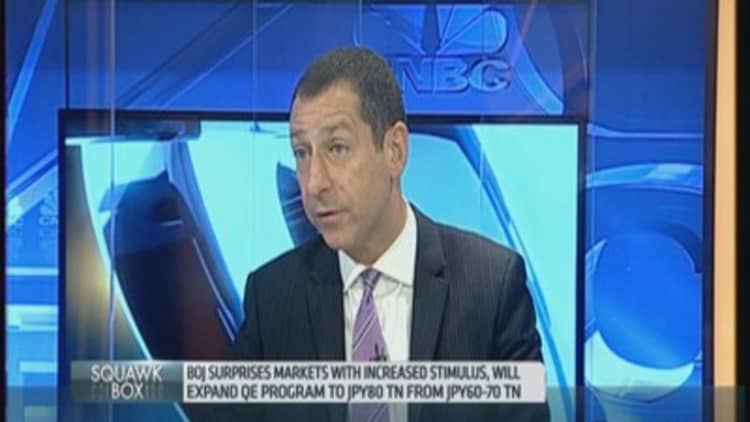The Bank of Japan Governor not only surprised the markets with his latest splurge of monetary easing. He sprang it on his own board members just two days earlier, jolted into action to stop them making a low-ball forecast that might have sunk his flagship inflation target.
To achieve maximum effect for the shock decision, Haruhiko Kuroda and right-hand man Masayoshi Amamiya kept only a handful of elite central bank bureaucrats in the loop as they laid the ground for the expansion of their quantitative and qualitative easing (QQE) program.
They didn't even give the usual forewarning to senior bureaucrats at the Ministry of Finance, according to interviews with nearly a dozen insiders and government sources with knowledge of the bank's deliberations.
No leaks reached the media, and the announcement at the Oct. 31 policy meeting pushed the stock average to seven-year highs and the to seven-year lows against the dollar.
Read MoreBOJ surprises with fresh stimulus, Nikkei surges 5%
The market reaction will have been welcome news to Kuroda, but the impact he wanted above all was to alter inflation expectations in a country that has struggled with crippling deflation for two decades.
Timing was critical - and not of his choosing. At the policy meeting the board would also issue a new consumer inflation forecast for the next fiscal year, based on the median estimate from the nine members. But two days before publication, the preliminary estimate was only around 1.5 percent, three of the sources said.
That was well below the 1.9 percent forecast made in July, and if published could have been fatal to his key goal of hitting 2 percent from April next year. Since price expectations play a key role in the consumer behaviors that ultimately determine prices, doubts about the target could be self-fulfilling.
There were other triggers for action, including October's plunge in oil prices and the fact that an easing burst would have more market impact in the week the U.S. Federal Reserve decided to turn its own liquidity taps off.
Read MoreBank of Japan battles entrenched 'deflation mindset'
But it was the inflation forecast that convinced Kuroda and his aides to go for another burst of stimulus, three sources said. Board members would then have to revisit their estimates in light of the new action.
It worked. They revised their forecasts to take account of the QQE injection, bringing the figure up to 1.7 percent, enough to keep Kuroda's target within sight and perhaps drain the growing pool of doubters.
Annual core consumer inflation was down at only 1 percent in September, prompting many to charge Kuroda with unfounded optimism. A Reuters poll of economists had forecast only 1.1 percent for the year to come.

Genie on the loose
Though Kuroda won the vote, which will boost the BOJ's government debt purchases by $260 billion a year and triple its buying of risky assets, he also paid a price for the manner and haste of the decision: a board split almost down the middle.
Read MoreBOJ's Kuroda vows to hit price goal, stands ready to do more
Because policy board members are barred from discussing policy without a quorum in a formal meeting, Kuroda sent BOJ bureaucrats as his emissaries to corral a majority for his easing plan, sources said.
He knew he had the votes of his two deputies, and that there was no hope of winning over the board's two market economists who have long expressed public doubts about QQE, especially Takahide Kiuchi, who wants the programme terminated in two years.
So fierce lobbying focused on the board's two former businessmen, Koji Ishida and Yoshihisa Morimoto.
Despite frantic efforts, he failed to win them over. Worse, though they had rarely voiced open doubts about QQE before, their opposition would now become public.
Read MoreAbe balances tax rise against economic damage
The sources said the swing voter was the hard-to-predict former academic Ryuzo Miyao, who took a long time to convince.
One suggested Kuroda had let a genie of dissent out of the bottle, which could make future easing decisions more difficult to achieve.
"Those who dissented this time may be inclined to dissent again if the BOJ were to ease further," said the source.
Takeshi Minami, chief economist at Norinchukin Research Institute and one of just four of the 19 economists who had correctly forecast the Halloween surprise in a Reuters poll, expects the bank will want to ease again in mid-2015.
Read MoreBOJ bazooka to spark currency war
If so, Kuroda, whose determination to stay the course is unflagging, could well need Prime Minister Shinzo Abe to stack the BOJ board with reliable reflationists when Miyao's term ends in March and Morimoto's in June.
"In order to completely overcome the chronic disease of deflation, you need to take all your medicine," Kuroda said on Wednesday. "Half-baked medical treatment will only worsen the symptoms."

